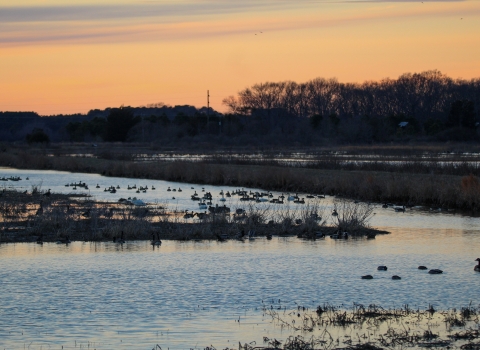PORTLAND, Oregon – In a move signaling the success of ongoing conservation efforts in the Pacific Northwest and the benefits the Endangered Species Act (ESA) affords our most at risk wildlife, the U.S. Fish and Wildlife Service has proposed to downlist the Columbian white-tailed deer from endangered to threatened. The Service is opening a 60-day public comment period on the proposal.
The Columbian white-tailed deer joins a growing list of species listed under the ESA that are making progress toward recovery in the Pacific Northwest. That list includes the Oregon chub, delisted in February 2015; the Modoc sucker, proposed for delisting in February 2014; the gray wolf, whose population is expanding; and the greater-sage grouse, which was not listed under ESA thanks in part to agreements to protect sagebrush sagebrush
The western United States’ sagebrush country encompasses over 175 million acres of public and private lands. The sagebrush landscape provides many benefits to our rural economies and communities, and it serves as crucial habitat for a diversity of wildlife, including the iconic greater sage-grouse and over 350 other species.
Learn more about sagebrush habitat on public and private lands.
“This combined effort between the Service, states, tribes and conservation groups demonstrates the success of the ESA in bringing stakeholders together to bring imperiled species back from the brink of extinction,” said Richard Hannan, the Service's Deputy Regional Director. “By working together to reduce threats and establish secure subpopulations of Columbia white-tailed deer, their numbers are now at a record high. The continued conservation success in the Pacific Northwest illustrates what we can accomplish when we all work together.”
The Service worked closely with the Washington and Oregon departments of fish and wildlife, the Cowlitz Indian Tribe and numerous other partners to help restore Columbian white-tailed deer populations.
“We are gratified by the progress that has been achieved towards recovery of this very important component to our culture,” said William Iyall, Chairman of the Cowlitz Indian Tribe. “We began our focus on recovery through a Fish and Wildlife Service Tribal Wildlife grant in 2008, which we believe forged a positive path towards partnership and recovery. We long for the day and will continue to do our part to see Columbian white-tailed deer fully restored and delisted from the Endangered Species List.”
There are two populations of Columbian white-tailed deer: the Douglas County population in the Umpqua River Basin of Oregon was removed from the endangered species list in 2003 due to recovery; this downlisting proposal applies to the Lower Columbia River population, which is found in Wahkiakum, Cowlitz and Clark counties in Washington, and Clatsop and Columbia counties in Oregon.
The Columbian white-tailed deer was listed in 1967, due to habitat loss and modification by human activities, such as farming and logging, as well as commercial and residential development. Since then, the Lower Columbia River population has experienced significant recovery, going from about 450 deer in 1967 to more than 900 individuals today.
The recovery was enhanced by the establishment of the Julia Butler Hansen National Wildlife Refuge for the Columbian White-tailed Deer in 1971 to protect the deer. There are now three subpopulations at or near the refuge: on the refuge mainland, on the refuge’s Tenasillahe Island, and on private Puget Island.
Risk of a recent levee failure threatened to put portions of the refuge under water. To reduce this risk to the deer population, hundreds of volunteers and staff moved 88 Columbian white-tailed deer over a three-year period to Ridgefield National Wildlife Refuge, about 45 miles southeast. This newly translocated population is expected to grow and become a viable and secure subpopulation.
Along with the downlisting proposal, the Service is also proposing a 4(d) rule under the ESA to exempt certain ongoing land management activities from the Act’s “take” prohibitions, when those activities are conducted in a manner consistent with the conservation of the deer. Take is a term under the ESA that includes harassing or harming listed species. If the proposed downlisting is finalized, the 4(d) rule would give states and private landowners enhanced management flexibility without reducing the effectiveness of conservation actions or the recovery of the species.
As a part of the public comment period, the public is encouraged to submit any new information on the Columbian white-tailed deer and its habitat by December 7, 2015. This information will help in the Service’s final evaluation of whether the species should be reclassified as threatened.
For more information about Columbian white-tailed deer and to view the proposal and instructions on how to submit comments, visit http://www.fws.gov/oregonfwo/articles.cfm?id=149489413.


